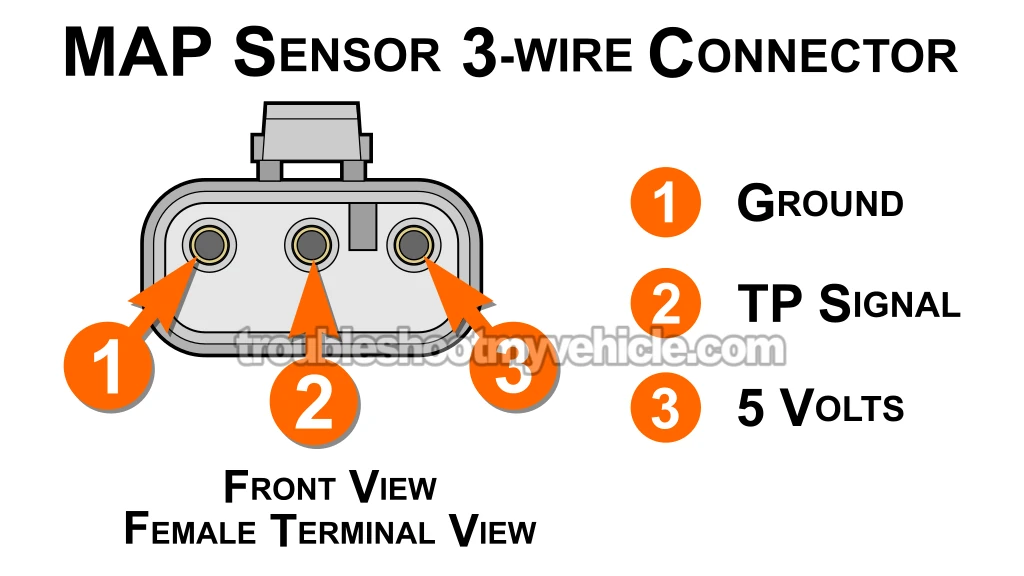TEST 3: Verifying The MAP Sensor Ground Circuit

Alright, based on the results from the last two tests, here's what we know:
- First, the MAP sensor isn't generating a variable voltage when vacuum is applied or released (TEST 1).
- Second, the sensor is receiving proper power —specifically, between 4.5 and 5 Volts DC (TEST 2).
Now it's time for the final check —let's confirm whether the sensor is getting a solid Ground connection. You'll use a multimeter to perform this test.
The process is simple. You'll be testing the black with light blue stripe (BLK/LT BLU) from the MAP sensor's 3-wire connector. This wire supplies the Ground signal to the sensor.
IMPORTANT: This Ground wire connects straight to the fuel injection computer. Be cautious —never connect it directly to 12 Volts from the battery. Doing so can permanently damage the computer. The method described in the steps below uses a safe voltage test to confirm whether Ground is present in the circuit.
Follow these steps to test for a proper Ground connection:
- 1
Unplug the MAP sensor from its electrical connector.
- 2
Connect the red test lead of your multimeter to the battery's positive (+) terminal.
- 3
Set the multimeter to measure DC voltage.
- 4
Turn the ignition key to the ON position, but don't start the engine.
- 5
Use the black multimeter lead to probe the terminal marked with the number 1.
This terminal connects to the black wire with light blue stripe (BLK/LT BLU) in the connector. - 6
You should see a reading between 10 and 12 Volts DC if Ground is present.
Now let's interpret your test results:
CASE 1: Your multimeter shows 10 to 12 Volts. This confirms the sensor is getting a proper Ground signal from the computer.
In this case, the MAP sensor is faulty and should be replaced —but only if you've verified all of the following:
- The sensor doesn't produce a variable voltage during the vacuum test (TEST 1).
- It receives 4.5 to 5 Volts DC power from the computer (TEST 2).
- It has a confirmed Ground connection (as shown in this test).
Want to save some money on a replacement MAP sensor? Check out my top picks here: Where to Buy the MAP Sensor and Save.
CASE 2: You didn't get a 10 to 12 Volt reading. Double-check your setup and retest to rule out connection issues.
If there's still no voltage, this explains why the MAP sensor isn't producing a signal —it's missing a proper Ground.
That means the sensor itself is probably fine. The issue now is restoring that missing Ground connection. Most likely causes include:
- A break or fault in the Ground wire between the MAP sensor connector and the computer.
- In rare cases, a problem within the fuel injection computer itself.
MAP Sensor Code Won't Go Away
So, you've already gone through the MAP sensor tests and everything checks out fine. But that stubborn check engine light is still on —even after you've cleared the diagnostic trouble code (DTC) from the system?
Let's dig a bit deeper. There could be other issues triggering that code. Here are some common culprits that can mimic a bad MAP sensor:
- Significant vacuum leak: A major vacuum leak can throw off the air/fuel ratio, cause rough idling, and trick the computer into thinking the MAP sensor is at fault.
- Cracked or broken vacuum hose: Inspect the rubber hose running to the MAP sensor. If it's hardened, cracked, or falling apart, that could easily cause the problem.
- Poor engine compression: Low compression in several cylinders can result in unstable vacuum and rough idle. It's worth performing a compression test to be sure:
- MAP sensor with intermittent faults: Sometimes, a sensor can work fine one moment and fail the next. Try lightly tapping it with a screwdriver handle while applying vacuum. If the voltage reading jumps or cuts out, you've found the problem.
- Loose or damaged MAP sensor connector: Check the connector closely. A broken locking tab or loose fit can cause spotty connections and inconsistent readings.
- Weak fuel pump: If the fuel pump is starting to fail, it might not deliver the right amount of fuel or pressure. That can throw off performance and trigger fault codes. Be sure to test fuel pressure:
More 3.9L V6 Dodge Ram Van Tutorials
I've written several more tutorials for the 3.9L V6 Dodge Ram vans and you can find them in this index:
Here's a sample of the tutorials you'll find in the index:
- How To Test For A Blown Head Gasket (1989-2003 3.9L V6 Dodge Ram Van).
- How To Test The Engine Compression (1989-2003 3.9L V6 Dodge Ram Van).
- How To Test The Fuel Pump (1992-2003 3.9L V6 Dodge Ram Van).
- How To Test The TPS (1992-1997 3.9L V6 Dodge Ram Van).

If this info saved the day, buy me a beer!

